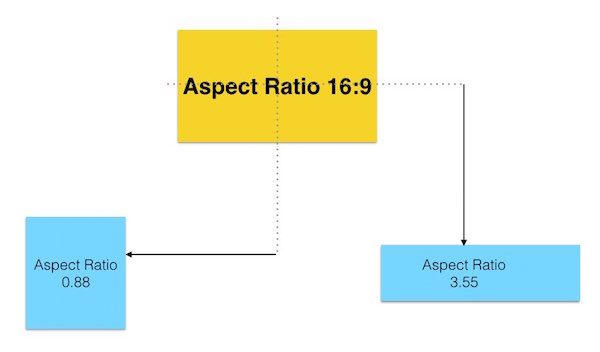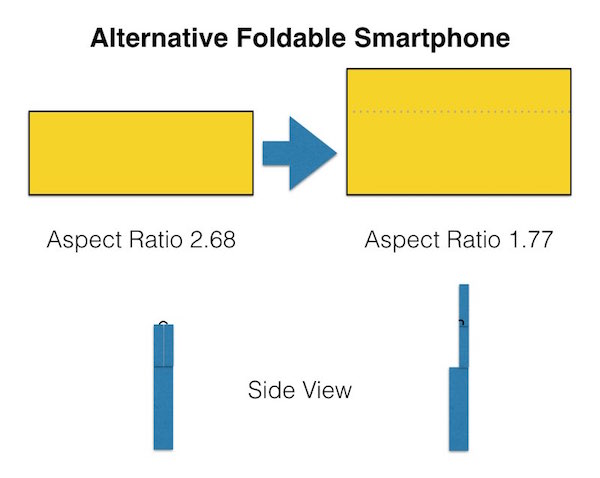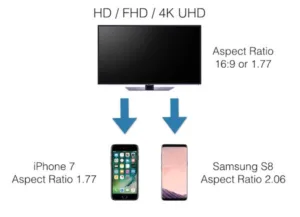When we think of a smartphone or a phablet we do have a certain size in mind. A smartphone fits in almost every pocket, while the phablet does need a sufficiently-sized pocket. To be more specific, the most important high end smartphones are coming from Samsung and Apple for now. These two are the market leaders in smartphone design that everyone else strives to emulate.
Of course there are significant differences in the design itself, however the sizes are very similar and typically differ only by a few millimeters. Currently the smartphone is a device just under 140mm x 70mm and the phablet is a little larger at about 160mm x 80mm. The display is somewhat smaller compared to the outside dimensions, however the trend goes clearly towards bezel-less phones where the dimensions equal the display size.
HD aspect ratio drives the mobile display screen aspect ratio
Looking at the actual display aspect ratio, we can see that the Apple displays have an aspect ratio of 16:9 or 1.77, which means that all HD type content fills this display perfectly. Samsung’s new S8 flagship model on the other hand deviates a little from this aspect ratio with a value of 2.06. The phone itself has an aspect ratio of 2.19, which means that there is still a little top and bottom area on the phone that is not covered by a display. This black area is defined by the round edges. This means that the S8 has the largest rectangular display that will fit into the housing.
Considering using a flexible display in such a device, would allow for a range of alternative designs. However, even with a foldable display, the use of the device with the display fully extended would not change much from today’s use patterns. Watching video would be pretty high on the list. When we look at video more or less all content created in the last few decades is based on a 16:9 aspect ratio. Going forward with UHD and beyond this will remain the more or less only constant.
As a consequence, the unfolded display should roughly resemble a 16:9 aspect ratio to maximize the useable viewing area. While this may not be true for other uses like gaming, texting, etc., it is difficult to believe that the marketing people developing the concepts will go to a new technology that allows for a larger display without giving video viewing some serious consideration.
So far display size has been shown to be one of the drivers for consumer adoption in the direction of “Bigger is Better”. Once the bezel has been completely converted to viewing area, the only way to increase the viewing area is making the device larger unless you can fold up the display screen.
 The aspect ratio of smartphones with folded displays are awkward
The aspect ratio of smartphones with folded displays are awkward
Unfortunately, when you unfold a display once you are changing the aspect ratio. For example starting with the folded display having a resolution of 1920×1080, you end up with either a 3840×1080 or 1920×2160 sized display. In terms of aspect ratio we are looking at either a 3.55 (32:9) or a 0.88 (8:9) display. This assumes that the display is folded in half, which it may not be. On idea would be to make the phone smaller in width and fold out only a portion of the phone to create a 16:9 aspect ratio.
To overcome this inherent issue, a display size similar to the ISO (Din) A paper series would be much easier to handle. The ISO A paper series has an aspect ratio of 1.414. If this reminds you of the square root of 2, you are absolutely correct. As the consequence, folding the long side in half creates a sheet with the same aspect ratio. This of course would be the perfect solution for a foldable display. Interestingly the old 4:3 (1.33) aspect ratio is much closer to the 1.414 aspect ratio than the HD format.
 An alternative foldable device would only fold up a part of the display
An alternative foldable device would only fold up a part of the display
Besides this perfect solution, it is more than doubtful that all content providers will agree to reformat to an 1.414 aspect ratio if that would be even possible. The current movie theater aspect ratio is either 1.85 or 2.39 , with 1.85 being pretty close to 1.77 making a transformation pretty simple without too many artistic concerns. Since the IMax aspect ratio is about 1.43, such a foldable perfect display could be showing IMax movies without any issues. We could look forward to the release of IMax mobile for our mobile entertainment.
A device that has only part of the display folding up has another important advantage. When we look from the side we see that a foldable display would double the thickness of the device, something that would go against the common understanding that thinner is more desirable. If only part of the display folds out, the rest could be the original thickness housing important things like battery, processor, and other parts. The foldable part could house only the display allowing for a thinner device overall.
I am trying to imagine what real life advantages a foldable smartphone will have in our content driven world. The closest I can foresee is a partially folded device that starts out with a narrower phone (like some of the modern remote controls) that expands into a full sized phablet with an aspect ratio around 1.77 for all our Hollywood (among other places) entertainment. Other than that I just see a technically complicated solution to a requirement that is not very high on the list of use cases. (NH)

